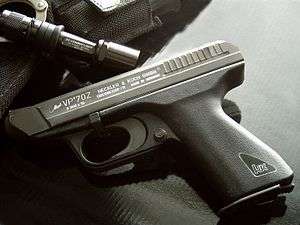Heckler & Koch VP70
The VP70 is a 9×19mm, 18-round, double action only, semi-automatic/three-round burst capable polymer frame pistol manufactured by German arms firm Heckler & Koch GmbH. VP stands for Volkspistole[1][2][3] (literally "People's Pistol"), and the designation 70 was for the first year of production: 1970.
| Heckler & Koch VP70 | |
|---|---|
 VP70Z variant | |
| Type | Machine pistol |
| Place of origin | West Germany |
| Service history | |
| Used by | See Users |
| Production history | |
| Designed | 1970 |
| Manufacturer | Heckler & Koch |
| Produced | 1970–1989 |
| Variants | VP70M, VP70Z |
| Specifications | |
| Mass | 820 grams (28.9 oz) empty |
| Length | 204 millimetres (8.0 in) |
| Barrel length | 116 millimetres (4.6 in) |
| Height | 142 millimetres (5.6 in) |
| Cartridge | 9×19mm Parabellum 9×21mm IMI (VP70Z only) |
| Action | Blowback |
| Rate of fire | 2200 rounds/min (3-round burst mode) |
| Effective firing range | 50 m |
| Feed system | 18-round box magazine |
Design
The VP70 combined a number of design features that were innovative, or at least very unusual for its time:
- It was the first polymer-framed handgun, predating the Glock 17 by 12 years. (Although the Remington Nylon 66 rifle introduced in 1959 was the first polymer-framed firearm in production.) At 820 g (28.9 oz) unloaded, the weapon is lighter than most metal framed pistols of the time.
- As on the Mauser C96 the stock was designed to be used as a holster when not mounted. On the military version of the VP70 this combination includes a unique feature: When mounted, a selective fire switch, located on the stock, allows switching the weapon to a three-round burst mode, with a 2,200 rounds per minute cyclic rate of fire.
- The VP70 uses a spring-loaded striker like a Glock, instead of a conventional firing pin.
- It is double action only so the trigger pull is relatively heavy.
- In lieu of a blade front sight, the VP70 uses a polished ramp with a central notch in the middle to provide the illusion of a dark front post.
Unlike the military VP70M, the civilian VP70Z does have a safety. It is the circular button located immediately behind the trigger and is a common crossblock safety. On the military frame, this is replaced with a non-functional plug.
Variants

The handgun comes in two varieties. The "M" (Militär, military) variant is selective-fire (semi-auto/three-round bursts), the "Z" (Zivil, civilian) variant is a semi-automatic only version. While the "Z" version originally has no provision to mount the stock, it can be fitted after minor alterations to the handgrip.
Four hundred VP70Zs were made in 9×21mm IMI; these samples were made primarily for the civilian market of Italy, where the use of the 9×19mm Parabellum is permitted only to military and law enforcement agencies. All of the VP70Z pistols sold to Italy had the provision to mount the stock, but still lacked the three-round burst firing capability.
Users
References
- Kersten, Manfred; Schmid, Walter (1999). HK- Die Offizielle Geschichte der Oberndorfer Firma Heckler & Koch [The Official History of the Oberndorf Firm Heckler & Koch] (in German). Weispfennig. ISBN 978-3000050916.
- David Higginbotham. "The HK VP70 The First Polymer Framed Pistol". Guns.com. Retrieved 2013-11-10.
HK says the VP [...] means Volks Pistole or People’s Pistol [...] This is where another (erroneous) name for the pistol comes from. Vollautomatische Pistole.
- Jack Lewis (2007). The Gun Digest Book of Assault Weapons (7th ed.). Iola, Wis.: Gun Digest Books. p. 250. ISBN 978-1-4402-2652-6.
Around 1970, Heckler & Koch developed the selective-fire VP70 (VolksPistole: People's Pistol) with the reported hope that it would be chosen to arm village militias in Vietnam.
- Jones, Richard D. Jane's Infantry Weapons 2009/2010. Jane's Information Group; 35th edition (January 27, 2009). ISBN 978-0-7106-2869-5.
External links
| Wikimedia Commons has media related to: |